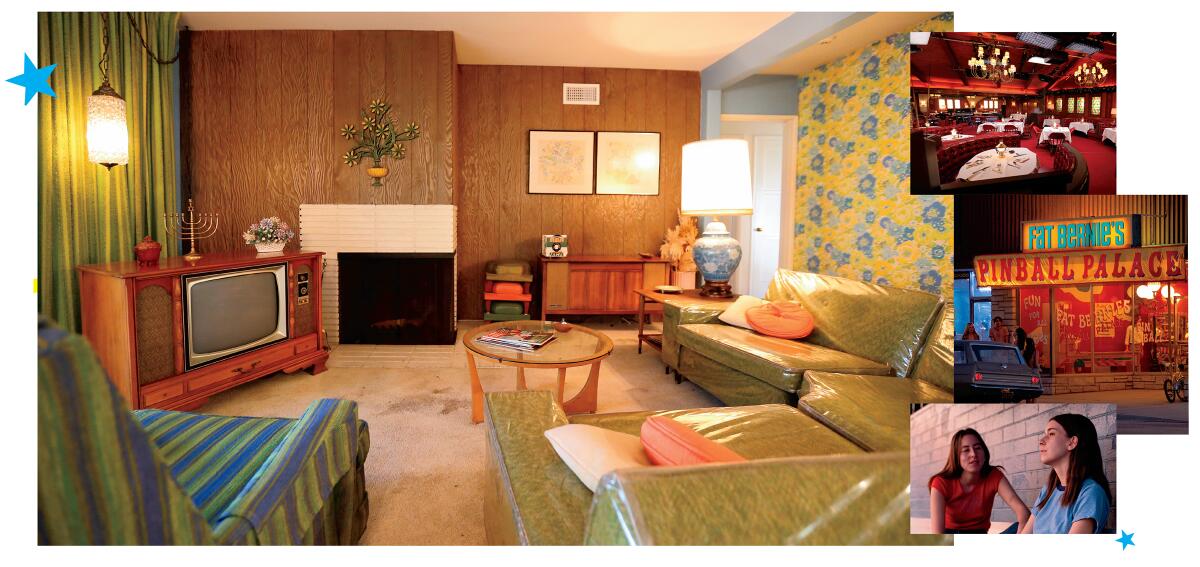Plastic-covered sofas, waterbeds and dark restaurants: The Valley of ‘Licorice Pizza’

- Share via
When Florencia Martin was hired as production designer on “Licorice Pizza,” she knew what would bring credible San Fernando Valley energy to its early 1970s setting. “There was lots of signage then. Storefront signage, bus stop signage. Hand-painted signs on glass, signs with cut plastic letters,” says Martin, who turned to the Los Angeles Times archives for research. “We just decided, ‘We’re not going to fictionalize the Valley.’”
Martin first met “Licorice Pizza” director Paul Thomas Anderson when set decorating his 2012 drama, “The Master.” But she credits a pair of his low-budget music videos for the Valley-based band Haim with teaching her what Anderson wants. “Working closely with a small group of people actively producing and shooting something on location, there’s a dialogue,” says Martin. “Just seeing the way Paul shoots, you understand how to approach something.”
“Licorice Pizza” opens at Portola Middle School. What was essential to establishing that it’s in the Valley?
The big gym, the big, open arcade where Alana (Alana Haim) and Gary (Cooper Hoffman) first meet, the sprinklers going. I grew up in West L.A. thinking that every school looks like that. Then I went to college in Pittsburgh and saw what other high schools look like and realized, “Oh, that’s a California-style school.”
What’s it like to read a script with an entire waterbed subplot?
I was like, “I know waterbeds.” My stepdad had a waterbed, my high school boyfriend had a waterbed. We found names of people who are still in the business in an L.A. Times article. I went to [American National Manufacturing] in Corona, knocked on the door and told [owner Craig Miller] what I was doing. His eyes lit up. He said, “Come with me,” and out he pulled two shoe boxes of Polaroids of the entire manufacturing process. The waterbeds [in the movie] were custom-built from [those] Polaroids. With all the films I work on, I’m always on the hunt for a firsthand account. It gives you the foundational base, and you develop from there.
For example?
Paul talked about how he and his sisters would go to Tail o’ the Cock to eat dinner at 5 p.m. It was still light out, but you’d step inside and it was so dark you couldn’t tell what time it was. Everyone would fall asleep in the booth while their parents were on their third cocktail.
The original eatery closed in the ‘80s. Why Billingsley’s, the defunct restaurant, as the replacement?
We didn’t want to shoot at any of the red-booth steakhouses in L.A. — lots of films have already been shot there. So we looked at Billingsley’s, where Paul shot “Magnolia.”
Billingsley’s had these huge windows that looked out onto a golf course. I came up with a design that enclosed the windows. Everyone wanted me to use plexiglass [for the stained-glass]. But I was like, “No, no.” I knew Paul would like to see light through them. We found someone in San Diego who still works with textured glass and was able to have 24 stained-glass windows manufactured on our budget.
This wasn’t just about buildings, though, was it?
We spent lots of time hunting for [locations] people take for granted but are iconic to the Valley. Large parking lots, endless back alleys, the bleachers where [Alana and her sister] get high. The cul-de-sac by the house. That’s all Paul and his knowledge of the Valley. Very early on, if we passed a good alley or parking lot, we’d make a note of it.
Talk about finding Alana’s family home.
We scouted in the flats, north of Ventura Boulevard. That’s the demographic for a middle-class family then. I loved the open plan style, the way the camera tracks from the living room to the dining room and kitchen and hallway. It tells the audience the story of American architecture and family homes. When the [real estate] boom happened in the San Fernando Valley in the 1950s, all of these smartly designed tract-style houses were built, a full house with a backyard on a small plot of land.
Besides a well-placed menorah, how did you convey that the Kanes are Jewish?
I told my set decorator, Ryan Watson, to go on eBay and find things from that era from Israel that were part of the Jewish tradition. We also found plastic-covered sofas. When I showed the boards to Alana, she went, “I can’t believe it! My grandma had [sofas] like these.” She had an immediate connection to that style of furnishing.
When did you realize that a comfortable set might help first-time actors forget they were being filmed?
We had locations locked early on. So we went to locations and watched them interact with the set. It became clear that it was important to give them an immersive experience. We taught them everything from how to build and make a waterbed to how to fix a pinball machine. We wanted to make sure that it was second nature to them, that it became this unspoken thing. For rehearsal at Gary’s house, five teen boys came in with McDonald’s bags and French fries, and they took off their clothes and jumped in the pool. They were grabbing stuff off the shelves, playing with the toys and making a mess. It brought me so much joy. It just felt like they lived there.
More to Read
From the Oscars to the Emmys.
Get the Envelope newsletter for exclusive awards season coverage, behind-the-scenes stories from the Envelope podcast and columnist Glenn Whipp’s must-read analysis.
You may occasionally receive promotional content from the Los Angeles Times.










